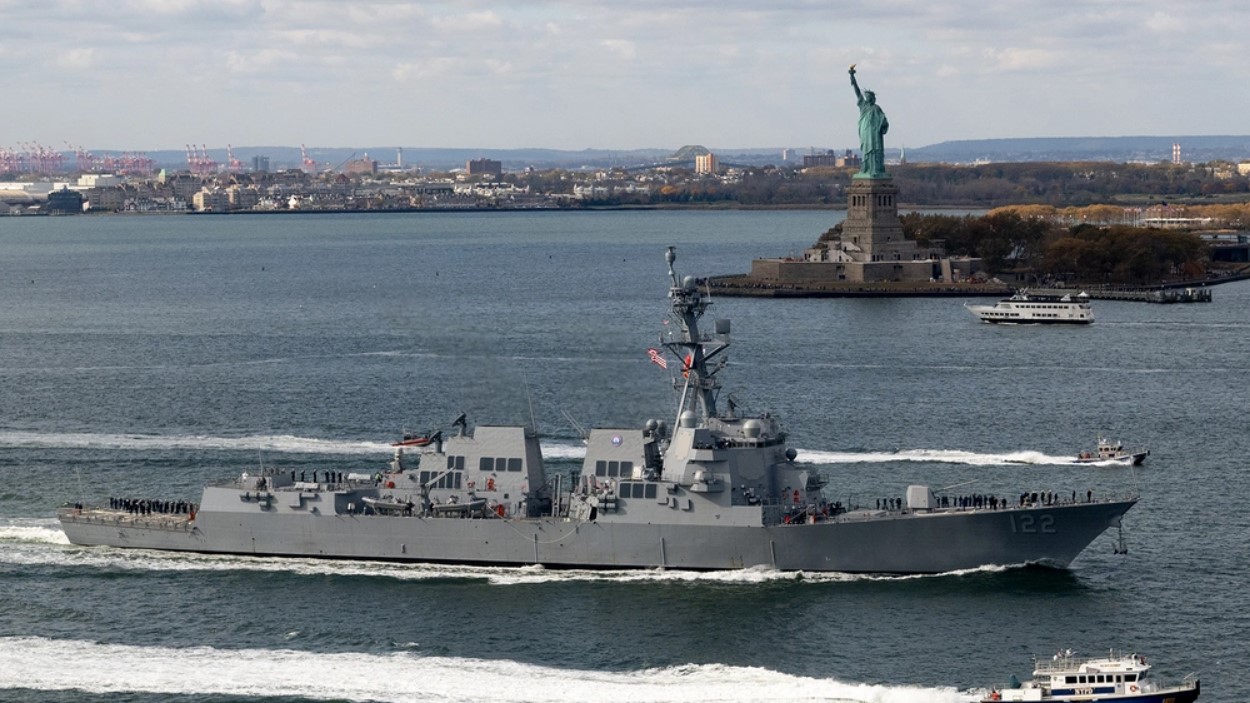

Eighty-two years ago, Marine John Basilone ran through enemy lines, ferrying ammunition to his fellow troops as fierce fighting waged on the island of Guadalcanal. His actions helped hold off Japanese attacks and earned Basilone the Medal of Honor. He became a hero not just for the Marine Corps but for Americans during the war.
Now the Navy has a new destroyer named in his honor. The USS John Basilone, an Arleigh Burke-class guided-missile destroyer, was officially commissioned by the U.S. Navy on Saturday, Nov. 9.
The ceremony was attended not just by the crew, but Navy and Marine Corps leadership, several Marines and Secretary of the Navy Carlos Del Toro. It was held in New York, only a few miles from Basilone’s childhood home. The destroyer was commissioned just a day before the Marine Corps’ 249th birthday on Nov. 10.
The ship was christened in 2022, bearing the name of Gunnery Sgt. Basilone, “one of the most decorated Marines in our nation’s history,” as Del Toro noted. Born in 1916 in Buffalo, New York, Basilone originally served as a soldier in the Army. He served for three years, mostly in the Philippines, his first time in the Pacific. After his enlistment ended, he then joined the United States Marine Corps, where he would become legendary. He joined in 1940, but when the United States entered World War II, Basilone was shipped off to the island of Guadalcanal.
A machine gunner with 1st Marine Division, on Oct. 24, 1942, his unit came under attack from a full regiment of Japanese forces. Marines suffered heavy casualties, leaving Basilone as one of the few standing. Ammunition was low, and the line was being overwhelmed. That night and into the next day, Basilone manned his machine gun, firing from the hip without hand protection even as the hot barrel damaged his skin. Running between positions, he worked to fight back against the surging Japanese forces, fighting with the machine gun and at one point a machete.
“A little later, with ammunition critically low and the supply lines cut off, Sgt. Basilone, at great risk of his life and in the face of continued enemy attack, battled his way through hostile lines with urgently needed shells for his gunners, thereby contributing in large measure to the virtual annihilation of a Japanese regiment,” his Medal of Honor citation reads. “His great personal valor and courageous initiative were in keeping with the highest traditions of the U.S. Naval Service.”
Subscribe to Task & Purpose today. Get the latest military news and culture in your inbox daily.
He was awarded the Medal of Honor after the battle ended. Basilone would be shipped home, embarking on a war bonds fundraising tour. However he requested to return to the war. He reenlisted in the Marines, training new recruits and joining them when they shipped off. He landed on Iwo Jima in February 1945. Fighting from the beaches towards an airfield, he moved his unit through heavy fire before he was killed by a Japanese attack. He was 28. After his death, Basilone would be awarded the Navy Cross, the Marine Corps’ second-highest honor. Basilone was the only enlisted Marine to earn both awards during the entire war.

Basilone remains an inspiration for current Marines, and in fact his legacy is part of the final stage of recruits’ training, the crucible. It is something Lt. Gen. Roberta Shea, head of United States Marine Corps Forces Command, noted at the ceremony.
“For every single Marine, whether trained at Parris Island, South Carolina or San Diego, California, Gunnery Sgt. Basilone’s legacy is brought to life in that crucible,” Shea said. “Their drill instructor will read his Medal of Honor citation, and recruits reflect on his bravery, his selfless sacrifice and leadership as they tackle obstacle after obstacle.”
The new destroyer is the latest to be named for the late Marine. In 1949, the Navy commissioned the USS Basilone, a Gearing-class destroyer. The ship sailed through several different seas, including deployments to the Mediterranean Sea, being sent to the Middle East during the Suez Canal crisis and heading to the waters around Vietnam during the Vietnam War, until it was decommissioned in 1977.
The Arleigh Burke class of destroyers is the Navy’s workhorse, capable of engaging in prolonged fights and providing anti-air defense. Ships of the class have been active in the waters around the Middle East, where destroyers have proved crucial in shooting down drones and missiles fired by Houthis from Yemen towards commercial ships in the Red Sea and Gulf of Aden. The USS John Basilone is a Flight IIA variant of the destroyer class, able to fight against aerial and underwater threats. Del Toro noted the struggles of the world today, saying that the ship was entering service in the time of new threats different than John Basilone encountered.
The destroyer has already been at sea, traveling to New York for its commissioning. As Military.com noted, the ship is sporting a distinctive battle flag, two crossed Browning M1917 machine guns next to a cross. The cross is the emblem of the 1st Marine Division that Basilone served in, while the two machine guns pay tribute to Basilone’s actions at Guadalcanal and Iwo Jima.
The latest on Task & Purpose
- Marine Corps corporal surprises little brother with EGA at boot camp ceremony
- Navy pilot spotted with patch depicting Houthis as ‘Star Wars’ sand people
- ‘All about the money’ — VA employee’s accidental voicemail to veteran prompts investigation
- The Air Force is letting troops play this wargame on its secure networks
- DoD program makes it easier to enlist with ADHD, asthma, other medical conditions
